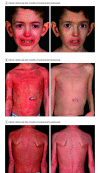Secukinumab Therapy for Netherton Syndrome
- PMID: 32459284
- PMCID: PMC7254452
- DOI: 10.1001/jamadermatol.2020.1019
Secukinumab Therapy for Netherton Syndrome
Abstract
Importance: Netherton syndrome (NS) is a rare, severe genetic disorder of cornification with high morbidity. Treatment for NS has been notoriously difficult. Recent studies showed an upregulated helper T cell (TH) 17/interleukin 23 (IL-23) pathway in NS, suggesting the possibility of treatment strategies that target IL-17.
Objective: To evaluate the clinical response of NS to treatment with the IL-17 antagonist secukinumab.
Design, setting, and participants: This case series study reports the experience of compassionate use therapy with secukinumab in 4 patients with severe NS, including 2 children, from December 1, 2018, to December 1, 2019, with 3 patients still undergoing treatment at the time of final analysis. Data were analyzed from December 1, 2018, to December 1, 2019.
Main outcomes and measures: Expression of IL-17 in the skin was evaluated by immunohistochemical analysis, and serum cytokine concentrations were measured using a commercially available assay. Treatment response was assessed using the Ichthyosis Area and Severity Index (IASI) total score, including measures of erythema and scaling, the Dermatology Life Quality Index (DLQI), and the 5-D itch scale.
Results: In all 4 patients (age range, 9-27 years; 3 male and 1 female), immunostaining with an IL-17A antibody showed an increased number of positive cells in lesional skin. Cytokine assessment in serum samples revealed increased levels of CCL20. Treatment duration with secukinumab was 3 to 12 months at the time of this report. After 3 months of therapy, IASI scores were reduced by 44% to 88%, DLQI scores were reduced by 40% to 76%, and 5-D itch scale scores were reduced by 27% to 62%. This outcome was sustained at the 6-month follow-up. Two patients with an erythrodermic phenotype showed marked improvement of all parameters. A refractory palmoplantar eczematous eruption occurred in 2 patients, and a candidal nail infection developed in 2 patients. No severe adverse events were reported.
Conclusions and relevance: This initial case series reporting the use of anti-IL-17 therapy in NS demonstrated marked cutaneous improvement, particularly in 2 pediatric patients with erythrodermic phenotypes. Further studies are needed to evaluate the long-term benefit of this potential treatment modality.
Conflict of interest statement
Figures


Comment in
-
Pathogenesis-Based Therapy With Repurposed Biologics for Monogenic Inflammatory Skin Disorders.JAMA Dermatol. 2020 Aug 1;156(8):839-841. doi: 10.1001/jamadermatol.2020.1018. JAMA Dermatol. 2020. PMID: 32459286 No abstract available.
References
Publication types
MeSH terms
Substances
LinkOut - more resources
Full Text Sources
Other Literature Sources
Research Materials
Miscellaneous

